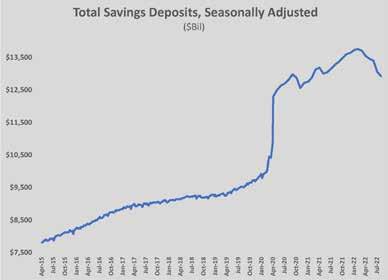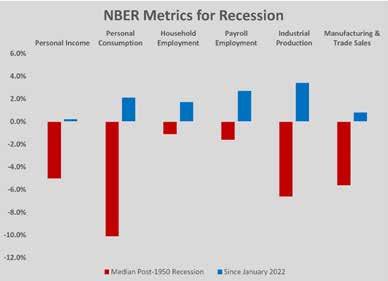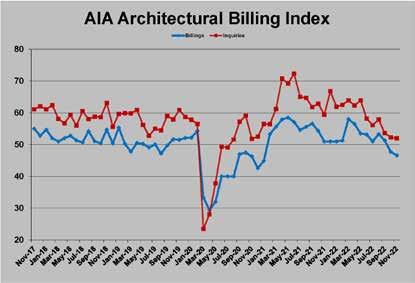
10 minute read
NATIONAL MARKET UPDATE
Almost across all industries and geographic markets, 2022 was a disappointing year for business. The persistent high level of inflation softened demand for products and services as the year unfolded. Central bank monetary policy tightened to the point of becoming restrictive to growth and, indeed, gross domestic product (GDP) declined in the first and second quarter. However, neither consumers nor businesses reacted to higher interest rates with the kind of pullback that shocked the U.S. economy into recession. The lingering question that remains from 2022 then is whether recession looms for 2023.
With inflation showing signs of easing as 2022 ended, there is more of an opening for the Federal Reserve Bank to pause rate hikes and allow disinflation to play out. But, with the job market remaining as tight as during periods of peak employment, the Fed has more incentive to push the envelope until unemployment begins to rise. The consensus in the markets is that the target range for Fed Funds will reach 5.0 to 5.25 percent before rate hikes cease, likely not until the May meeting. So, will 2023 bring recession? The year ahead will bring decisions from consumers, employers, and policy makers that will balance restraint (or retrenchment) against the desire for growth. The trade-off of spending versus saving, hiring versus downsizing, and tightening versus easing will determine whether or not the U.S. economy contracts. The signal that is the strongest indicator of a coming recession is a change in consumer spending. Despite countless anecdotes of how inflation is squeezing household finances, personal consumption remained strong through 2022. The source of that strength, at least in part, was the extreme jump in personal savings in 2020 and 2021. Shutdowns and government largesse combined to allow consumers to save an average of nearly 19 percent of their disposable income from March 2020 to March 2021 (compared to an average 7.5 percent since 2000). That led to household savings of roughly $13.8 trillion. More than $1 trillion of that buffer was depleted in 2022 through October. Following a record holiday splurge, consumer savings will be at pre-pandemic levels in January 2023. Absent that cushion, and with inflation still outpacing wage gains, consumers may be forced to tighten their belts through the first half of 2023.
Savings deposited in U.S. financial institutions declined by nearly $1 trillion since March 2022. Source: Federal Reserve Bank.

One reliable – if not irrefutable – indicator of an impending recession is the inverted yield curve. Such an inversion, in which the interest rate of short-term bonds exceeds that of long-term bonds, suggests that investors are hedging concerns about the health of the economy by buying short-term U.S. Treasury debt. In midDecember, the 3-year Treasury was yielding between 3.8 and 4.1 percent (compared to 0.87 percent a year ago), while the 10-year note was yielding 3.5 percent (compared to 1.6 percent a year ago). An inversion of six months, such as is
A comparison of data used by NBER to judge whether or not the economy is in recession is still showing expansion. Sources: Bureau of Economic Analysis, Bureau of Labor Statistics, Federal Reserve Bank, National Bureau of Economic Research.
currently the case, foretells a recession six to 12 months later. While many media outlets jumped on the two consecutive quarters of negative GDP to declare recession, the National Bureau of Economic Research (NBER) – the private, nonprofit founded to make such a declaration official – did not. NBER takes declining GDP into account, but also looks at a variety of other economic metrics to determine whether a recession is, or has, occurred. None of those metrics have turned negative since the end of 2021, let alone approached the declines associated with a median post-1950 recession. In fact, two of those measures, payroll employment and industrial production, have been well above the GDP trend, growing by 2.7 percent and 3.4 percent respectively. Moreover, the GDP growth rate for the third quarter rose to 2.9 percent, nearly a full point above expectations. Another recession indicator that arose as a result of research done by Claudia Sahm, an economist formerly with the Federal Reserve and the Council of Economic Advisors, finds that a recession occurs when the three-month moving average for unemployment rate moves 0.5 points above the low mark for the previous 12 months. Using the so-called Sahm Rule, unemployment will have to climb above four percent before recessionary conditions occur. As 2023 begins, the inverted yield curve anticipates recession soon. The Sahm Rule indicates that unemployment has another 50 basis points of room to move. And the NBER has few, if any, metrics to suggest that a recession looms. The conflicting signals create a dilemma for policy makers. For the Fed, the dilemma is compounded by the fact that its actions take 12 months to bring results. With each monthly report that shows inflation remaining persistent, even if the rate of inflation slows, it is difficult to entertain the idea reducing or pausing rate hikes. Thus, the current restrictive path the Fed has taken will be followed until signs of recession appear. A slowdown in hiring or a significant increase in
unemployment would be such signs; however, in every business cycle over the past 40 years, the unemployment rate did not begin to tick upwards until after the Fed stopped raising rates. That makes the unemployment rate a poor leading indicator. Into December, when the reports on November’s inflation showed significant cooling from mid-summer highs, unemployment remained low, and more than 10 million job openings remained unfilled. The sources of inflation were narrowed primarily to the services and shelter sectors. Those sectors remained near double-digit inflation rates; however, it is worth noting that each is a lagging indicator that requires a tighter job market to drive prices lower. Apartment leases renew each month, so only 10 percent or so of the shelter prices are Both billings and inquiries have softened for architects since the end of summer. Source: American Institute of Architects. subject to current market forces. Service prices trend closely with wages. Until more people are losing jobs, both sectors will see elevated prices year-over-year. As the fourth quarter began, the labor market was decelerating. Through the first half of 2022, employers averaged 444,000 new hires each month. From September through November, that rate slowed to 262,000, the slowest since the start of 2021. Responses from employers in the Fed’s Beige Book indicate that hiring plans are diminished for 2023. That would bring job gains down further or lead to losses that would bring some relief to the monetary tightening. And there was significant anecdotal evidence of layoffs. Amazon announced plans to lay off 10,000 workers the week before Thanksgiving. Meta told investors that it was cutting its staff by 13 percent, or by more than 11,000 employees, in response to poor results. Morgan Stanley cut its global staff by two percent in December. There are additional signs that the economy is cooling in ways that would relieve inflation. Shipping giant, Maersk, reported that its expectations are for a slowdown in activity in 2023. The Drewry World Container Index had fallen 40 consecutive weeks by Thanksgiving and shipping rates were more than 70 percent lower than the peak in September 2021. At the end of November, the backlog of ships waiting offshore to access the Los Angeles/Long Beach port was zero, down from a high of 110 in January 2022. Indicators of a global recession are much stronger than those pointing to a recession in the U.S. Unlike the past few cycles, central banks have been well coordinated in their efforts to squash inflation. But, for most other regions of the world – including the European Union, Great Britain, and emerging economies – the monetary squeeze of higher borrowing costs began when their economies were much weaker. To compete against U.S. Treasury bonds and avoid weakening their own currencies, other countries have raised interest rates in step with the Fed. That has meant crippling economic growth in most of the rest of the world. A steep global recession would deflate price escalation and allow the

Fed to reverse its rate hikes in the second half of 2023. Such a recession would also bring economic pain to the U.S. consumer. The impact of a slowing economy has begun to show up in the construction market data. Construction spending remains near all-time high levels because of high double-digit inflation but has leveled since summer 2022. The latest reading by the Census Bureaus showed total spending at $1.795 trillion in October, down 1.3 percent from the July 2022 peak. Total nonresidential spending was 9.8 percent higher than October 2021, roughly 10 percentage points lower than the year-over-year rate of inflation for nonresidential building. Housing starts continued a year-long decline. From a peak of 1.8 million units in May, housing starts have fallen to a 1.4-million-unit pace. Construction of single-family homes has slowed more than the overall housing market. In part, this is because the quick, sharp rise in mortgage rates had a more immediate impact on buying decisions for homeowners. Conversely, the longer lead time for multifamily development means that apartment construction lags behind single-family in responding to market disruptions like rate hikes. Through October, developers were on pace to build 70,000 more units in 2022 than in 2021. That pace is expected to cool in 2023, although demand for rentals remains strong. A leading indicator that has softened since the end of summer is the American Institute of Architects’ (AIA) Architectural Billings Index (ABI). A monthly survey of AIA member firms, the ABI reflect the direction of billings, new project inquiries, and design contracts. Readings above 50 indicate more firms are seeing increases than decreases. Because architectural services lead construction by as much as 12 months, the ABI is an accurate indicator of construction activity in the coming year. Through summer, ABI had been solidly positive, a trend that stretched back to February 2021. Inquiries had been increasing in six of 10 firms for most of 2022. Beginning in September, however, all three indicators of architectural demand weakened, with billings falling to 46.6 in November. Backlogs at architectural firms remain strong, at roughly seven months; however, if the current trend holds, construction will be slower by mid-year 2023. The countervailing pressure to the slowing trend is the unusually high number of projects previously designed but not released for construction due to higher inflation and economic uncertainty. A mid-2023 shift in perception about the economy or in construction costs would boost construction ahead of a reversal of trend in architectural activity. The indicators from architects, absent such a shift, suggests that construction will slow over the coming year. The results from the mid-term elections should be neutral to the construction market. The flipping of the majority in the House of Representatives means a divided government, something that is generally viewed as favorable for business. Republican control of the House is tenuous, which should protect against dramatic changes in direction. At the same time, a Republican House of Representatives is less likely to pass legislation that increases government spending on construction significantly. Public construction will not get a boost from a divided government, but private construction should not see further regulation. And the major federal legislation to boost infrastructure, power, and manufacturing projects during the 117th Congress will be slow to turn into construction contracts because of regulatory hurdles and the “buy American” restrictions of the law. Perhaps the best indication of how much or how little construction will rebound in 2023 will come from the path of inflation. If the easing of inflation evidenced in the fall of 2022 turns to falling prices in the first quarter, owners and developers will have more confidence that their projects will not suffer from unforeseen cost increases. That will be especially true if the economic data continues to show that higher interest rates are leading to a soft landing, rather than a demand-crushing recession. The coming months present an opportunity for a turning point in the direction of the U.S. economy. The March Federal Open Markets Committee (FOMC) meeting will be the first for which the rate hike expectation is not baked in (assuming the February hike of 25 basis points occurs). March’s meeting will be the first opportunity to pause rate hikes, action that the Fed has been reluctant to take. Winter will have ended in Europe, and with it will come an opportunity to see energy prices fall. That would significantly ease inflation overall. By the time the FOMC meets and acts in March, the U.S. should have a good idea about whether a soft landing or recession is in the cards for 2023.
BG
Construction spending has begun to decline from cyclical highs, even with double-digit inflation. Source: U.S. Census Bureau.








